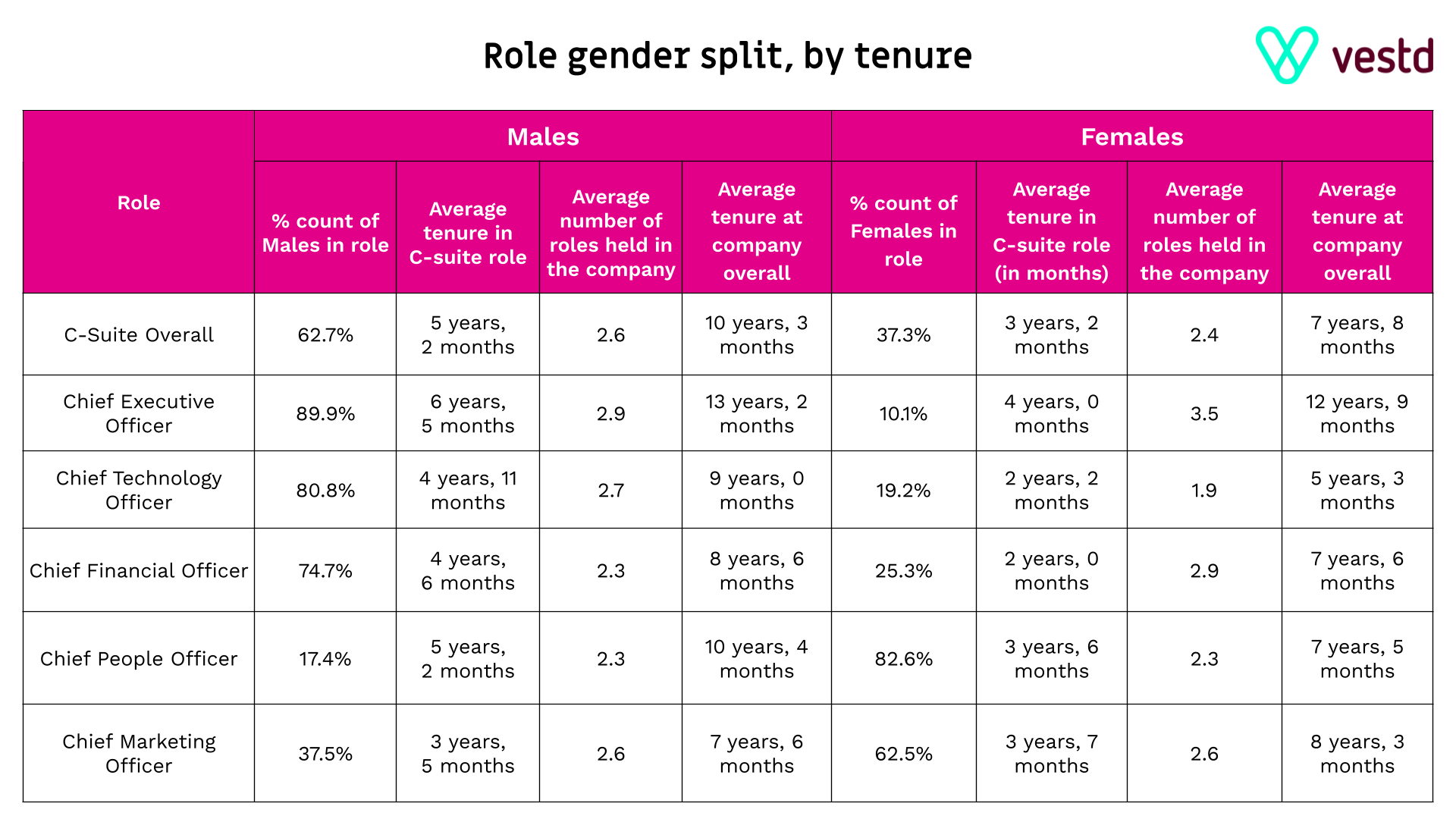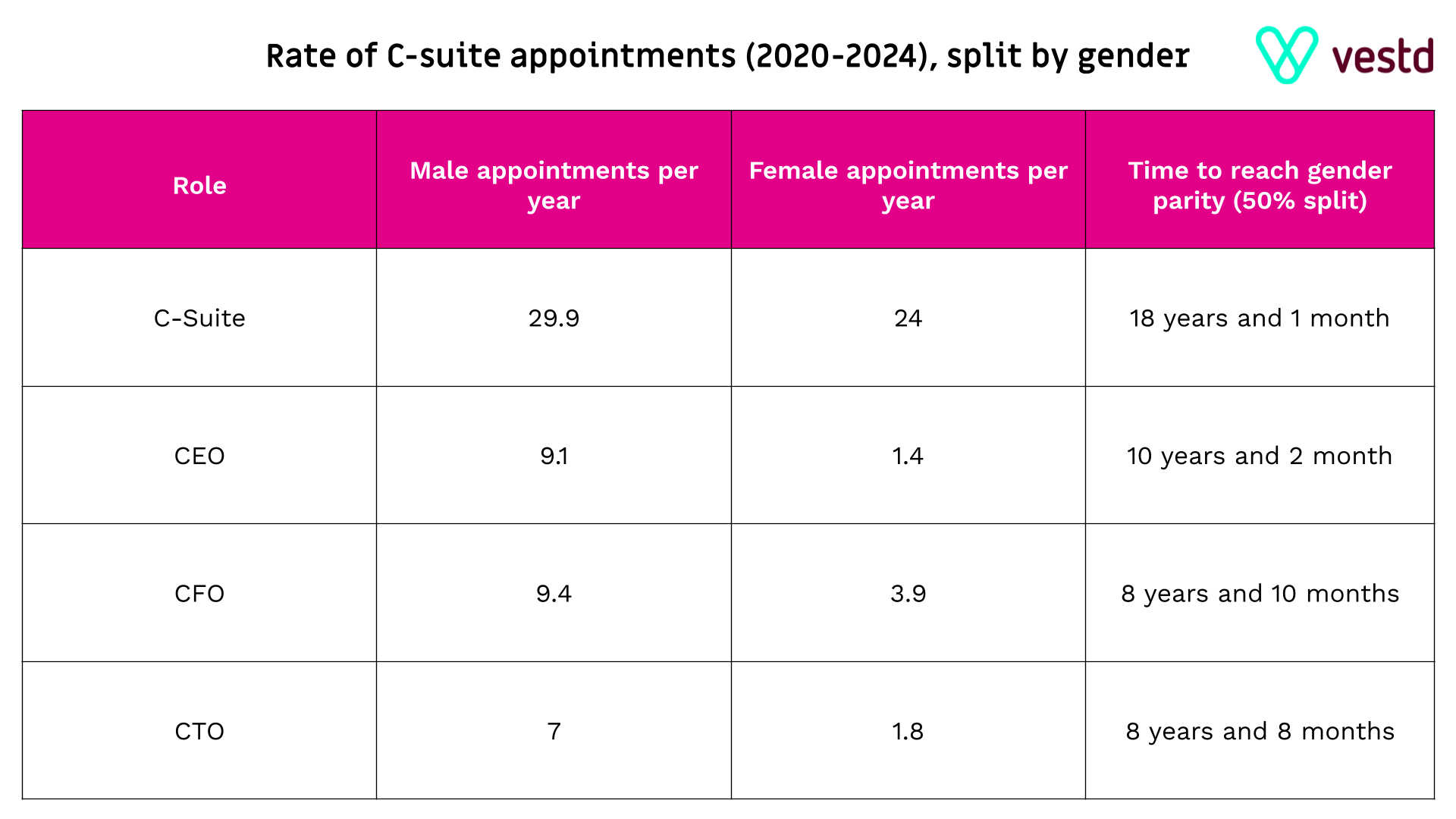
Closing the leadership gender gap could take 18 years
Women occupy less than two-fifths of executive leadership positions in the UK’s FTSE100 companies, with new data warning it will take 18 years to close the gender gap.
The research, part of the ‘C-Suite Churn Report’ created by sharetech platform Vestd, analysed employment tenure trends, gender representation, educational backgrounds, and employee sentiment across five C-suite roles (CEO, CFO, CTO, CPO, CMO) in the UK’s FTSE100 companies listed on the London Stock Exchange.
The report found that women remain largely underrepresented across nearly every C-suite role, making up just 37.3% of executive positions overall.
Once at the leadership level, female executives were found to serve far shorter tenures of just three years and two months, compared to five years and two months for their male counterparts on average.
Female leaders had the highest churn rate in the Chief Financial Officer role, with an average tenure of just two years.
This was followed closely by those in the Chief Technology Officer role, where women stayed nearly three years less than men on average, and accounted for just 19% overall.
The data shows that women were also approximately 8 times more likely to be appointed to a Chief People Officer role than men in FTSE100 companies, occupying over 82% of current positions. Despite this, tenure gaps persist as females stay in the role for one year and eight months shorter than men on average.
Although the number of female appointments year-on-year has increased over the last five years, it is at a far slower pace, with approximately 24 female leadership appointments per year compared against almost 30 male appointments on average.
This comes as a recent study found more than half (60%) of women consider the presence of female leaders to be a key factor when deciding to apply for or accept a job.
To that, 40% cited a lack of access to senior roles as a primary reason for changing jobs to progress, while 34% overall perceived their gender to be a barrier to career progression.
Despite a lack of representation, female CEOs were found to have a far higher approval rating on average, at 83% versus 76% for male CEOs, highlighting a disparity between leadership perceptions and the opportunities available.
Despite this, female CEOs typically face heightened scrutiny and bias over performance and leadership. Recent analysis found that female CEOs were 2.1x more likely than males to be described as “too ambitious”, and 2.1x more likely to be described as “lacking ambition” than male CEOs.
Gendered language also remains a persistent issue, with female CEOs 27% more likely to be described using people-orientated language, while male CEOs are 34% more likely to be described for their task-orientated skills. Men are also twice as likely to be labelled as “innovators”, while females are 72% more likely to be described as “inspirational”.


Ifty Nasir, Founder and CEO of Vestd, commented on the findings: “Amid the current volatility in the market forcing business leaders to make increasingly difficult decisions, our ‘C-Suite Churn Report’ reveals an alarming pattern: executive tenures are shrinking while external hire rates are on the rise. Against this backdrop is the stark reality that gender parity in the UK’s FTSE100 remains nearly two decades away.
“The projected 18-year timeline to reach equality at an executive level, within businesses widely regarded as the benchmark for corporate standards, is unacceptable in 2025. It reflects not only a missed opportunity for diverse leadership approaches but also a systemic issue affecting how leaders are appointed and retained, and potentially impacting recruitment at a wider level.
“This is where equity-based incentives can help tie leadership performance to long-term company success. With schemes like growth shares and unapproved share options, companies can embed equity from the very top to help reduce the executive churn rate, encourage internal mobility, and support inclusivity for long-term growth.”
For more startup news, check out the other articles on the website, and subscribe to the magazine for free. Listen to The Cereal Entrepreneur podcast for more interviews with entrepreneurs and big-hitters in the startup ecosystem.

